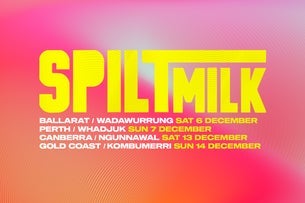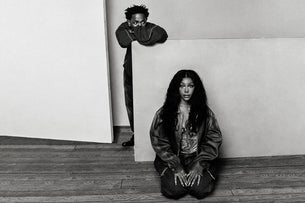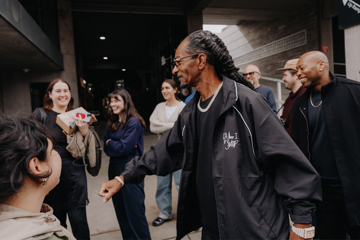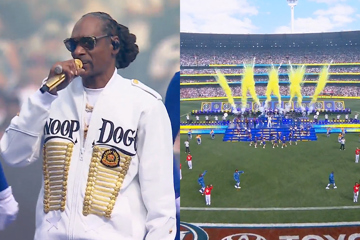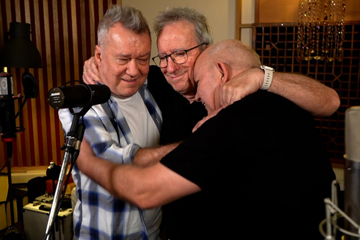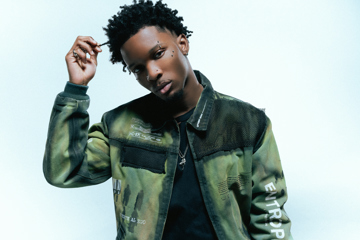Intel's Core Ultra AI Studio Shows How AI Can ACTUALLY Benefit Artists
“I think AI is nothing without the artists involved” – Ta-ku.

Ta-ku & Ninajirachi (Supplied)
Last week, Intel Core Ultra AI Studio set up in Melbourne Central to help demonstrate some of the ways that AI (artificial intelligence) collaboration can enhance and complement creative talent without overshadowing or replacing it.
Punters were invited to create one-off printed T-shirts using immersive graphics on Intel Core Ultra processors throughout the day. Three workshops were also hosted onsite – by photographer Demas Rusli, musician Ninajirachi and musician/creative director Ta-ku – and these proved to be fantastic networking opportunities for creatives wishing to connect with like-minded souls/future collaborators.
Our key takeaway: Develop your skill set and master your craft first, then do some research and check out whether AI tools can help you generate ideas, maximise productivity and perhaps even enhance your creative output.
Bespoke T-shirt installation
Set up in Melbourne Central’s Shot Tower Square, Intel Core Ultra AI Studio invited punters to generate one-of-a-kind designs – using Intel Core Ultra processors – which were printed onto T-shirts.
Don't miss a beat with our FREE daily newsletter
Intel tech supplied four different channels of immersive graphics for users to choose from as a jumping-off point. They then manipulated sliders – just like faders on a mixing desk – to refine their design. Once satisfied, participants just had to press the stop button and, violà! This unique design was printed directly onto a T-shirt! Demand was high and there was a bit of a backlog, so customers received a text message notification as soon as their unique garment was ready for collection.
Here’s how Ta-ku described this installation: “It’s just like an expression of how you can be creative at the touch of a button, or a slider, and create something – instantly – to wear. The notion of using AI to create something that is special to you and a one-off – no two T-shirts will be the same.
“I think they’ve done a real good job of showing the general public how AI can be fun and creative and a personal thing. And even if you don’t have a creative bone in your body, you can do this creative thing in the middle of Melbourne Central. It’s a good introduction to AI for people, ‘cause a lotta people still have no idea what it is or how it works.”
Even those with no artistic ability whatsoever can create something visually appealing using AI in this way, which is definitely a win.
Demas Rusli: Lights, Camera, AI
Street photography elevated with AI
Demas Rusli’s workshop focused on how he edits images using AI. “I use Lightroom in Photoshop to edit my photos and they’ve started to introduce more simple AI tools,” Rusli explained during our post-workshop chat.
Rusli’s most-used generative AI feature in Lightroom is the masking tool, which allows users to apply specific edits to selected sections within photos at the touch of a button. “You can literally change the colours of only the sky, right?” he marvels. “And then you can copy that mask for a different photo and it generates a new mask of that sky… It knows what’s the sky, what’s the subject, what’s the background, what’s the foreground and you can pick and choose what you wanna edit – that’s very handy when you’re editing a photo.”
So how would Rusli have achieved this before that masking tool feature was invented? “You would have to, like, paint it bit by bit,” he details, “and then for the next photo you would paint it a bit differently. So it was heaps slower. I also remove a lot of people in my photos. In the past, I would have had to clone one side of the photo to the other, or take multiple photos to get parts of photos to cut to mask them all in together. But now with the Generative Fill tool in Photoshop, you can just select it and AI will fill in that gap. It gives you three options as well – which one will you like best? – and it’s so fast.”
Denoise is another image-enhancing AI feature that Rusli rates. “I don’t know how I would’ve done it before,” he ponders, “but sometimes when you take a photo at night and it’s really dark you use a really high ISO in the camera and the photo’s super-grainy, right? There’s a feature in Lightroom called Denoise where AI enhances it and it turns into a really nice-looking photo, just by one click of the button. So that helps a lot, especially ‘cause I shoot a lot at night.”
Directly following his workshop, Rusli headed to the airport to fly back to Sydney and shoot for VIVID.

Ta-ku – AI as an aide for the next wave of creative directors
“I'm super-passionate about – and a bit of an advocate for – AI, to be honest,” Ta-ku confessed when we sat down to discuss his involvement with Intel Core Ultra AI Studio. “Over the years, I've been using different AI tools to aid the different creative things I'm into, and I’ve found it to be really powerful and quite liberating. I’m interested to see where it goes, for sure.”
Ta-ku had previously collaborated with Intel for his Sydney Opera House show as part of VIVID Live in 2016. “We used their tech for face scanning back in the day when it was new tech,” he revealed, “and used face scans for some of the visuals in my show. Their team is awesome. They helped me work out the tech and then, yeah! Fast forward to today and Intel brought me onto this project – looking at AI and what it means for society.”
So should songwriters and musicians feel threatened by AI? “You'll never be able to get an AI program to write a hit song that'll resonate with millions of people for generations to come, not from start to finish,” he reassured. “And if people know the song’s come from [AI], it won't have any lasting impact or credibility. ‘Cause, as humans, we always wanna know where the art comes from: who's behind the art? What's the story? What's the message? Without any of that stuff, the art is, you know, soulless or empty.”
In his creative director role at Pretty Soon, Ta-ku says he finds AI tools invaluable from the get-go – while brainstorming creative solutions for his agency’s clients: “It gets to a point where you're so overwhelmed that you use AI tools to kinda refine these crazy ideas in your head – to see what's possible. But also other [ideas] can sprout from exploring with AI.
“And, from there, you go out and use real artists to make this idea a reality… You can't really take real artists out of the equation. Ever. I think AI is nothing without the artists involved; they're the main part of it, and AI is just like that tool that elevates the creative or helps it become what it is.”
Pretty Soon has also often used AI to create music videos/visualisers. “If you've shot something already, AI gives you a completely new perspective on what's possible for visual styles,” Ta-ku shared. “We did a music visualiser for an artist in Italy where we took some photos of him in his hometown, and then remixed those photos to create different backgrounds.
“You get AI to remove the background – there's a button that [reads] ‘Remove Background’ and it takes, like, three seconds – and then you can generate a new background by typing, I dunno, ‘The artist is surrounded by a waterfall,’ or, ‘A dystopian future,’ and then you grab all those different generations and stitch them together to make this crazy, like, fever-dream sequence.
“I think stuff like that is really interesting and can help you nosedive into creativity and get active, and start experimenting. And it's kind of like removed that gatekeeper of going to uni for four years or something,” he acknowledges, laughing. “I'm a terrible student and I dropped out of every TAFE course. I wasn't smart enough for uni, so this kind of eclectic feel of creativity does suit my personality.
“The programs I use – you have to use original work; I have to use my photos, that's the base, and then you can add flourishes using AI. But as long as that original image is yours, that's where the ethics come into place. I would never take an image from someone else and then remix it to become mine, because that just feels icky, personally.
“I think the main focus for AI companies at the moment is making sure that it's ethical and that anything that you're using to create – or use as a base to create from – is your own work and you haven't just, like, taken an image and acted like it's yours.
“I think the AI companies are looking at ethics ‘cause they know it's important for people to want to be involved – you know, at least try it out – and to know they're taking steps to make it ethically safe. And companies like Intel are supporting artists to do things like this as well, you know? It's a good environment.
“Being transparent is important and there’s a lot of things around AI where policies need to come into place as well. But because it’s so new, we’ll see that happen over the next ten, 20 years.”

Ninajirachi – Making one-of-a-kind music better with AI
During her workshop, Ninajirachi also demonstrated Photoshop’s Generative Fill tool with great enthusiasm, showing us how easy it is to extend portrait images into landscape format.
Ninajirachi also listed a few ways she uses AI to supercharge her productivity: “AI can actually assist artists with the really menial parts of producing music, like fixing up a shitty vocal.” Some fellow producers in the group confirmed AI’s usefulness in managing and organising sample libraries through accurately sorting them into advanced categories based on the audio's characteristics (eg. acoustic, drums).
Her unconventional, innovative approach to music making sees Ninajirachi often experimenting with sonic offcuts or imperfections – the ‘faults’ AI isolates as suggested edits: what the De-esser plug-in identifies could become a humanised hi-hat beat, for instance.
“My favourite thing is audio junk or rubbish and just collaging out of that,” she confirmed during our chat afterwards. “It just makes music more interesting, texturally. I find that really interesting, especially because with synthesised music a lot of it is very pure and kind of perfect. And that’s why a lot of people like analogue synths, because they are imperfect.”
After acknowledging the rapid developments in AI technology, Ninajirachi shares: “People talk about how in 20 years people will feel nostalgic for this stage of AI, because they’ll look back and be like, ‘Oh, that was so cute. Remember when it used to get things wrong?’ ‘Cause it’ll be too good in the future and people will be nostalgic for this time.”

So what would these opinion leaders say to those among us who remain wary of AI?
Rusli: “I think give it a go and see if it improves your workflow, right? At the end of the day, it’s a tool and if it helps then why not, you know? If you don’t like it, then you don’t have to use it.”
Ninajirachi: “When I was approached to do this, at first I was a little bit apprehensive about saying yes because a lot of the people in my community – and my peers – aren’t really about AI in the arts, because so much of it is very morally grey and also kinda downright evil; like, the way some software just kind of steals from artists and then people can make money off their years of hard work and stuff.
“But then I also realised that’s the big conversation – as it should be – but there’s also a lot of really useful and totally ethical stuff that I am actually already using every day and I just didn’t realise it was AI-based until I looked into it. And then I was like, ‘Oh, this is actually really cool and AI’s not going away, and if anything it should be a good place for me to show people what I use and how it’s really cool!’”
Ta-ku: “It’s so new, you know? If you’re not within the creative industries, AI’s like this whole new world that’s intimidating and a bit scary.
“I think if you are sceptical – and it's good to be sceptical about everything – make sure you know what it is and that it's right for you. If you feel like it's not right for you, you don't need to force yourself to do things that you feel uncomfortable with… Have a tinker, have a poke around, do some research, and if you feel like it's for you, just start experimenting. Because I think you'll find that once you start the experimentation process, you'll realise how powerful AI can be: it just unlocks this new level of creative spontaneity within yourself.
“Before I started using it I used to kind of get creative fatigue, just from thinking about creative things all the time. But AI just helps you think about things in a new way. So I really encourage it. And, again, just research it – like when you buy a car, you know? [laughs] – figure out if it's right for you. If you believe it's got the right features and suits your workflow or your lifestyle, then that's all good.
“Once people can understand how AI can better our lives, it's up to everyone individually to make sure we use it responsibly. So that's where the research part comes into play: making sure you do it in a way that feels right as a human. If we all make that effort, AI will have its place in our lives but it won't take over our lives, you know. It's something that we can use responsibly to better ourselves and the work we do. I think AI’s future is largely in images and visual creativity, for sure.”
About the creators
Demas Rusli: A trusted partner and collaborator to many major brands and events, Sydney-based photographer/designer Demas Rusli is one of Australia’s most-followed photographers on social media (645,000+ Instagram followers). Known for his creative editing techniques and unique perspectives, Demas specialises in urban, architectural and aerial photography. His international brand campaigns to date include Samsung, Adobe, DJI, Nike and Etihad Airways.
Ta-ku: You’re probably already familiar with the musical output of Perth slashie (musician/producer/photographer) Regan Mathews, whose stage name Ta-ku is a nod to his Māori heritage (he’s half-Filipino, half-Māori). He’s been making music for over a decade, but Ta-ku admits he “didn’t really like touring”.
Picking up photography “as a hobby” while on tour eventually led Ta-ku to his current role as Creative Director at Pretty Soon, a creative agency he formed in 2018 with his buddy Ben Wright, which specialises in facilitating creative/art direction and creating bespoke visuals.
“I’m kind of like ‘master of none, okay at a bunch of things’,” he admits, laughing. “Trying different things helped me have, like, a creative opinion about certain things that I'm passionate about. For the last five years I’ve been working with brands and every creative project’s been different.”
To date, Pretty Soon has worked with global brands including Apple, Red Bull, Puma, G-Star and Nike.
Ninajirachi: Born Nina Wilson, Ninajirachi hails from the Central Coast of NSW and started making music during primary school. After being an Unearthed High finalist two years running, Ninajirachi has bloomed into a dance music visionary and in-demand remixer who is renowned for her constant innovation and tech savvy. Special mention: Ninajirachi made her EDC Las Vegas festival debut on the main stage less than a week prior to hosting her workshop this evening.
Related Gigs
